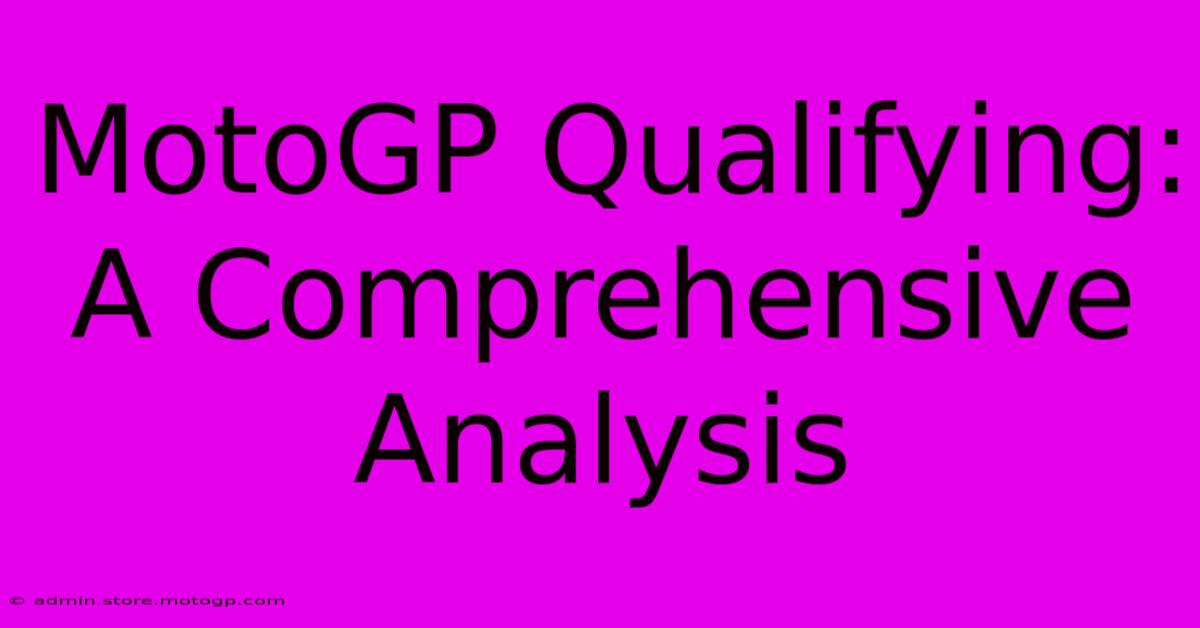MotoGP Qualifying: A Comprehensive Analysis

Table of Contents
MotoGP Qualifying: A Comprehensive Analysis
MotoGP qualifying is a crucial part of the Grand Prix weekend, setting the grid for the race and often heavily influencing the outcome. Understanding the intricacies of qualifying is key for any serious MotoGP fan. This comprehensive analysis delves into the process, the strategies employed, and the factors that contribute to a successful qualifying performance.
The Qualifying Format: A Breakdown
The current MotoGP qualifying format, introduced in recent years, is a multi-stage process designed to maximize excitement and ensure the fastest riders are at the front of the grid. It typically unfolds as follows:
-
Q1 (Qualifying 1): The riders who didn't finish in the top 10 in the combined Free Practice times (FP1, FP2, FP3) compete in Q1. Only the top two riders from Q1 progress to Q2. This initial session is often frantic, with riders pushing their limits to secure a place in the next round. Strategy in Q1 is often about a balance between finding a clean lap and saving tires for Q2 (if they make it).
-
Q2 (Qualifying 2): The top 10 riders from the combined Free Practice sessions, along with the two qualifiers from Q1, battle it out in Q2. The grid positions for the race are decided based on the finishing positions in Q2. The pressure is immense, as every tenth of a second counts. Tire management and track conditions play a significant role in this high-stakes session.
Key Factors Influencing Qualifying Performance
Several key factors significantly influence a rider's qualifying performance:
-
Rider Skill: Ultimately, the skill of the rider is paramount. Precise riding, exceptional bike control, and the ability to extract maximum performance from the machine under pressure are crucial. A rider's understanding of the track, including the best lines and braking points, is essential for setting a fast lap time.
-
Bike Setup: The motorcycle's setup plays a huge role. Fine-tuning the suspension, electronics, and aerodynamics to suit the specific track conditions is vital. Even a small adjustment can make a significant difference in lap times. Finding the optimal balance between speed and stability is key.
-
Tire Choice: Selecting the appropriate tires is critical, particularly considering the varying track conditions. Choosing the right compound and understanding the tire's wear characteristics throughout the session are crucial for achieving consistent performance and avoiding crashes. Tire pressure is also a key element that is continuously monitored and adjusted.
-
Track Conditions: The track's surface, temperature, and grip levels directly impact qualifying performance. Changes in track temperature throughout the session can necessitate adjustments in riding style and bike setup. Understanding the evolving track conditions is vital for a competitive performance.
-
Slipstream (Drafting): Drafting behind another rider can provide a significant aerodynamic advantage, reducing drag and allowing for higher speeds on the straights. Utilizing the slipstream effectively can be a decisive factor in achieving a fast lap. However, it requires precise timing and teamwork, often leading to complex strategies and potential risks.
-
Mechanical Reliability: A perfectly executed qualifying session can be undone by a mechanical problem. Reliability of the bike is critical. Even a small issue can mean the difference between a pole position and a disappointing start to the race.
Strategies and Tactics in Qualifying
Experienced MotoGP riders and teams employ sophisticated strategies to maximize their chances of securing a strong grid position. These often involve:
-
Tire Strategy: Deciding whether to prioritize a fast, single lap in Q1 or to use a more conservative approach and prioritize tire condition for Q2.
-
Slipstream Tactics: Coordinating with teammates or other riders to utilize the slipstream effectively during qualifying.
-
Data Analysis: Analyzing real-time data to monitor tire degradation and optimize bike setup.
-
Risk Management: Balancing the need for speed with the risk of a crash, which can have severe consequences.
Conclusion: The Importance of MotoGP Qualifying
MotoGP qualifying is far more than just a timed session; it's a strategic battleground where riders and teams put their skills, knowledge, and technology to the ultimate test. The starting grid position significantly influences the race outcome, making qualifying a critical element in determining the championship fight. Understanding the intricacies of qualifying allows fans to appreciate the depth of strategy and skill involved in this exhilarating spectacle.

Thank you for visiting our website wich cover about MotoGP Qualifying: A Comprehensive Analysis. We hope the information provided has been useful to you. Feel free to contact us if you have any questions or need further assistance. See you next time and dont miss to bookmark.
Featured Posts
-
Austin Gp Sprint Race The Heart Of Motorsport
Feb 20, 2025
-
Moto Gp Sprint How To Watch Live
Feb 20, 2025
-
Moto Gp Racing Time Predict The Winner
Feb 20, 2025
-
The Ultimate Guide To Types Of Motorbike Racing
Feb 20, 2025
-
Moto 3 Bikes From Beginner To Pro Your Moto 3 Journey
Feb 20, 2025
